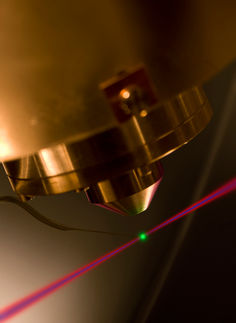Laser light produces complex nanostructures
Researchers at Chalmers University of Technology in Sweden have reported that a single laser pulse can create complex, ordered nanostructure systems. This previously unobserved phenomenon has just beeen described in an article in the scientific journal Nature Photonics. "We have discovered a method for controlling the pattern into which the nanoparticles organize themselves," says physicist Dinko Chakarov, one of the authors of the article. The complex nanostructures that are created may find applications in fibre optics, optical sensors and advanced light emitting diodes and lasers.
The researchers started with a layer of disordered nanoparticles of gold or silver on a membrane of nanometre thickness. The patterning is a consequence of several transformations of the light, which finally results in partial melting and moving of the nanoparticles.
First, the light is caught by the particles, resulting in resonant swinging back and forth of the particle electrons (so called localized plasmon resonances). This specific excitation gives rise to scattering and coupling of electromagnetic energy into trapped, waveguided modes of the thin membrane. The edges of the membrane cause a standing wave pattern to be formed.
The end result is hot and cold zones of a specific periodicity on the membrane surface, and if the laser light energy is high enough, the field energy in the hot zones is high enough to melt and move the gold particles. All of this occurs within a few nanoseconds or even faster, and the resulting patterns have dimensions that can be both smaller and larger than the laser wavelength.
The results demonstrate that complex nanostructured systems can be fabricated and manipulated by a single laser pulse. In addition, the study shows in a very concrete manner that assemblies of optically active nanoparticles can be used to trap light in a waveguide (membrane or fibre) with nanometer dimensions.
The researchers have shown that the pattern can be controlled by varying several parameters: the laser light angle, wavelength and polarization, as well as the membrane thickness and the type of particles on the membrane. The discovery contributes to the understanding of the fundamental interaction between light and matter.
Topics
Organizations
Other news from the department science

Get the analytics and lab tech industry in your inbox
By submitting this form you agree that LUMITOS AG will send you the newsletter(s) selected above by email. Your data will not be passed on to third parties. Your data will be stored and processed in accordance with our data protection regulations. LUMITOS may contact you by email for the purpose of advertising or market and opinion surveys. You can revoke your consent at any time without giving reasons to LUMITOS AG, Ernst-Augustin-Str. 2, 12489 Berlin, Germany or by e-mail at revoke@lumitos.com with effect for the future. In addition, each email contains a link to unsubscribe from the corresponding newsletter.

























































